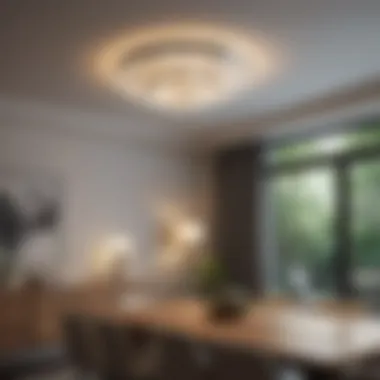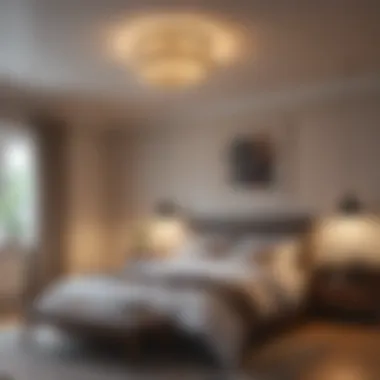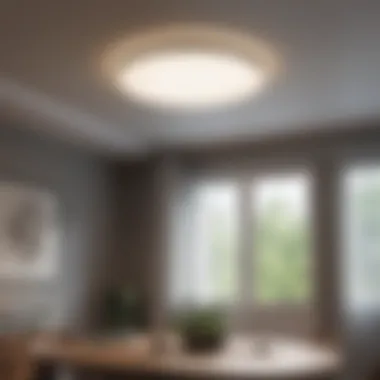How to Choose Ceiling Lights: A Comprehensive Guide


Intro
When selecting ceiling lights, various factors come into play that influence both functionality and appearance. Homeowners and design enthusiasts need to navigate through a plethora of options to make informed choices. This guide provides insights into the critical aspects of ceiling lighting, exploring the interplay between aesthetic and utility to enhance one's living space.
Design Inspiration
Trending Styles
A wide array of ceiling light styles exists, each fitting different decor themes. For instance, modern fixtures are sleek and minimalistic, while industrial designs favor raw materials like metal and glass. Traditional chandeliers, often ornate, bring a classic elegance to a room.
If your space leans towards eclectic, look at bohemian lighting which often incorporates colorful beads or unique shapes. Those seeking a rustic feel might gravitate towards farmhouse lights, characterized by their warm woods and metals. Ultimately, the style of the ceiling lights can influence the overall ambiance of your room significantly.
Color Palettes
Choosing a color palette for lighting is equally important. Neutral colors like white, black, or metallics help fixtures blend seamlessly with various decor styles. Alternatively, bold colors can serve as a statement piece. Look for colors that complement your room's theme. If you have warmer tones in your furnishings, consider gold or brass finishes.
For a cooling effect, silver or chrome can be effective, creating a modern and clean visual impact. Matching the light's color to the existing color scheme helps maintain a cohesive look throughout the space.
Practical Tips
Maintenance & Care
Ceiling lights require regular maintenance to ensure they function effectively and maintain their appearance. Dust and grime can quickly accumulate on light fixtures, impacting their brightness. A gentle cloth and mild cleaning solution can suffice for most fixtures. For detailed designs or chandeliers, consider using a soft brush to reach intricate areas. Ensure to turn off the power before cleaning any electrical fixtures.
Budgeting & Planning
Budgeting is essential when selecting lighting. It's crucial to balance quality and aesthetics within your financial plan. Determine how many fixtures you need and where they will be placed. Local hardware stores or online platforms often provide a range of prices for different designs. Do not ignore energy-efficient options like LED lights, which may have a higher upfront cost but save on electricity bills long-term.
"Investing in quality lighting can transform your home, enhancing both beauty and functionality without compromising your style."
In summary, ceiling lights hold the potential to dramatically alter the aesthetic and functional characteristics of any room. Careful consideration of styles, colors, maintenance, and budgeting will enable homeowners to make well-informed choices that align with their vision.
Understanding the Importance of Ceiling Lighting
Selecting proper ceiling lighting may seem like a minor detail in interior design, but its influence is significant. Light affects mood, perception, and functionality in a space. Proper ceiling lighting enhances living areas, emphasizing the style and atmosphere that homeowners strive for.
Defining Ceiling Lighting
Ceiling lighting refers to fixtures that are affixed to the ceiling of a room. These fixtures distribute light evenly across a space, providing essential illumination and enhancing visibility. Common types of ceiling lights include chandeliers, flush mounts, pendant lights, and recessed lighting. Understanding this definition establishes a foundation for discussing their varied applications and benefits in any home setting.
Roles of Ceiling Lighting in Interior Design
Ceiling lights play many roles in interior design, serving not just to light a room but to enhance its aesthetics. Here are some roles they fulfill:
- Ambient Lighting: This is the primary source of light in any room. It ensures that spaces are well-lit for everyday activities.
- Task Lighting: Specific fixtures can provide focused illumination for activities like reading, cooking, or working.
- Accent Lighting: This type highlights certain features in a room, such as artwork or architectural details, adding depth to the overall design.
"The right ceiling lighting can transform a dull room into an inviting space, showcasing its best features."
Every room can benefit from a careful selection of ceiling lights. Therefore, understanding their functions can significantly influence the comfort and utility of living spaces. As homeowners explore various options, these roles offer a clearer vision of how ceiling lighting contributes to the overall design and functionality of their home.
Evaluating Your Lighting Needs
Evaluating your lighting needs is essential before making decisions about ceiling lights. This process allows you to understand how light impacts each room's functionality and aesthetics. It takes into account both the size of the space and what activities you perform there. A well-planned lighting scheme balances these aspects, enhancing the overall ambience and usability of your environment. Factors like room layout and furniture arrangement directly influence the placement and type of lighting you should choose. Not recognizing these needs can lead to inadequate illumination or excessive brightness, which detracts from your room's usefulness and comfort.
Assessing Room Size and Layout
Room size is a critical consideration in lighting selection. Smaller rooms may require more focused lighting, while larger spaces might benefit from broader, more diffused light. It’s important to evaluate the dimensions of your space, including ceiling height, as this affects the type of fixtures you can use.
Consider these points for assessing your room size and layout:
- Ceiling height: Higher ceilings often need pendants or chandeliers to draw the eye upward. For low ceilings, flush mounts or recessed lights are better to avoid a cramped feel.
- Furniture arrangement: The layout can affect how light is distributed. Ensure lights are positioned to illuminate key areas like seating, workspaces, or display shelves effectively.
- Natural light availability: Observe how much natural light enters during the day. Rooms with ample sunlight may need softer lighting, while darker spaces may require brighter options.


Understanding Functionality Requirements
Understanding functionality requirements involves defining the purpose lighting will serve in each space. Different rooms require various types of light, which can be categorized as ambient, task, or accent lighting. Each type plays a specific role in creating a cohesive lighting strategy that meets your needs.
Ambient Lighting
Ambient lighting serves as the primary source of light in a room. It is essential for basic visibility. A key characteristic of ambient lighting is its overall uniformity. This helps to create a comfortable atmosphere without being harsh. Popular choices include ceiling fixtures, LED recessed lights, and chandeliers.
This type of lighting ensures that every corner of a room is sufficiently illuminated, allowing for movement and the performance of various everyday activities.
Unique feature: Ambient lighting can come from different sources like lamps or wall sconces, providing versatility in design.
Advantages:
- Sets the mood for the room.
- Provides a comfortable light level for general activities.
- Can easily match various interior styles.
Disadvantages:
- Might not be sufficient for tasks requiring more focused light.
- Overly bright ambient lights can be harsh.
Task Lighting
Task lighting is designed to illuminate specific areas where activities such as reading, cooking, or working take place. Its primary characteristic is intensity and focus. This type of lighting is beneficial for areas like desks or kitchen countertops.
Unique feature: Task lighting often comes from portable fixtures or adjustable sources, allowing the user to direct light exactly where it is needed.
Advantages:
- Enhances visibility for detailed tasks.
- Reduces eye strain during activities like reading or crafting.
Disadvantages:
- May require additional ambient lighting to balance overall illumination.
- If positioned incorrectly, it might cast shadows that hinder visibility.
Accent Lighting
Accent lighting adds highlights and creates visual interest within a space. It is used for emphasizing architectural features, artwork, or decorative elements. Its key characteristic is the ability to draw attention without overwhelming the ambiance of the room.
Unique feature: Accent lighting is usually adjustable and can be strategically placed to highlight specific areas or items in a room.
Advantages:
- Creates focal points that enhance design.
- Adds depth and dimension to the overall lighting scheme.
Disadvantages:
- Requires careful planning to avoid over-illumination or clutter.
- Solely relying on accent lighting can lead to insufficient overall illumination.
Evaluating your lighting needs lays the groundwork for a well-functioning lighting system that enhances both the form and function of your living space.
Types of Ceiling Lights
Choosing the right type of ceiling light is a fundamental aspect of interior lighting design. Each style of ceiling light serves specific purposes and can dramatically affect the ambiance of a room. Understanding the different options allows homeowners and design enthusiasts to select the fixtures that best match their needs and aesthetic preferences. Light fixtures must complement the overall design while providing adequate illumination in a functional way.
Chandeliers
Chandeliers stand out as a classic choice for ceiling lighting, often associated with elegance. These fixtures come in a variety of designs, from opulent to modern, making them versatile for different settings. Chandeliers can be focal points; their presence can elevate the entire room's decor. When selecting a chandelier, consider the scale of the room. A large chandelier can dominate a spacious dining room, while a smaller one may work well in a cozy nook. Additionally, installation height is important. Chandeliers should hang low enough to provide light but high enough to avoid interfering with movement.
Flush Mount Lights
Flush mount lights are practical and unobtrusive ceiling fixtures. They are mounted directly against the ceiling, making them ideal for low-profile spaces. These lights provide general illumination without breaking up the visual line of the ceiling. Flush mounts are particularly suitable for areas such as hallways or smaller rooms where space efficiency is a priority. When selecting flush mount lights, consider brightness and style. Models with integrated LED technology present energy-efficient options, serving both form and function.


Pendant Lights
Pendant lights add a dynamic element to ceiling lighting. These fixtures hang from the ceiling by chains or wires, allowing for flexibility in placement. A pendant light can serve as a statement piece above a kitchen island or dining table. It can create intimacy while also providing task lighting. When choosing pendant lights, consider the height from which they hang. They should be low enough to allow for sufficient light on work surfaces but high enough to avoid obstruction. Multiple pendants can also be grouped together for an increased visual impact.
Recessed Lighting
Recessed lighting, or can lights, are installed within the ceiling, providing a clean and modern look. This type of lighting is ideal for illuminating specific areas without visible fixtures, thus keeping the ceiling line clear. Recessed lights can be used for general lighting, task lighting, or accent lighting, depending on placement and bulb choice. It is important to plan the layout carefully to ensure adequate coverage and avoid dark spots. Recessed lighting is energy-efficient, especially when using LED bulbs, making it a popular choice among homeowners seeking sustainability.
Track Lighting
Track lighting offers versatility and adjustability in ceiling lighting. Comprising a series of light fixtures on a continuous track, it allows homeowners to direct light precisely where it is needed. This type of lighting is especially beneficial in spaces with varying tasks or activities, such as art studios or work areas. Track lighting also enables a mix of light sources, combining focused light with ambient lighting. When choosing track lighting, consider the length and design of the track to ensure it complements the decor. It's possible to use different bulbs and styles within the same track to achieve a customized look.
Design Considerations
Design considerations play a crucial role in selecting ceiling lights. They influence not only the aesthetics of a room but also the functionality and atmosphere. A well-designed lighting setup can enhance the overall appeal of your space, creating a harmonious interaction between light and design. By focusing on specific elements such as style, color temperature, and material selection, homeowners can better reflect their tastes and meet their lighting requirements.
Choosing the Right Style
Modern
Modern ceiling lights are characterized by sleek lines and a minimalist approach. This style contributes to a clean, uncluttered look. A key characteristic of modern lighting is its focus on function while maintaining a streamlined appearance. It is a popular choice because it easily integrates with various interior designs. One unique feature of modern lights is the use of innovative materials and technology, such as LED integration. The advantages include energy efficiency and a longer lifespan. However, the downside can be the often higher upfront costs associated with modern fixtures.
Traditional
Traditional ceiling lights often incorporate classic designs and intricate details. Their contribution lies in creating a warm, inviting atmosphere. A defining characteristic of traditional lighting is its ornate features, like decorative shades and wrought iron accents. This style is a beneficial choice for those looking to create a cozy, timeless look. A unique feature of traditional lights is their ability to blend with various decor styles over the years. The disadvantages might include more complex maintenance due to the design intricacies.
Industrial
Industrial ceiling lights draw inspiration from old factories and warehouses, characterized by raw materials and a utilitarian look. Their contribution to interior design can be significant, offering an edgy, urban feel. The key characteristic of industrial lighting is its use of exposed bulbs and metal finishes. This style is beneficial for those wanting to make a bold statement in their space. One unique feature is the emphasis on function over form. However, the stark appearance might not align well with softer decor themes, which can be a disadvantage.
Minimalist
Minimalist lighting is all about simplicity and functionality. This style emphasizes clean lines and unadorned forms. A primary characteristic of minimalist ceiling lights is their lack of ornate details, leading to a serene environment. It becomes a popular choice for modern homes, emphasizing space and light without clutter. One unique feature of this style is that it often utilizes neutral colors which blend easily with various decors. However, it may lack the warmth and character found in more elaborate styles, which could alienate some homeowners.
Color Temperature and Brightness
Color temperature is essential when choosing ceiling lights. It indicates the warmth or coolness of the light emitted. Warmer light, measured in Kelvin, creates a cozy atmosphere, ideal for living rooms and bedrooms. On the other hand, cooler light is suited for work environments, offering clarity and focus. Balancing brightness also influences how a space feels. Too much brightness can be harsh, while too little may lack functionality. Thus, understanding the appropriate levels of color temperature and brightness helps in effectively illuminating spaces, contributing to overall comfort.
Material Selection
Metal
Metal ceiling lights are renowned for their durability and modern appeal. A key characteristic is the use of various finishes, such as brushed nickel or matte black, enhancing versatility. This makes metal a beneficial choice for many design themes. The unique feature of metal fixtures is their robustness and ease of installation. However, they can often become hot if exposed to direct light for long periods, which might be a concern for some households.
Glass
Glass ceiling lights bring elegance and sophistication to any space. The key characteristic is transparency, allowing light to diffuse beautifully. This quality makes glass a popular choice for creating ambient lighting. A unique feature of glass is its ability to come in various shapes and colors, providing options for customization. However, it can be more fragile than other materials, which is a disadvantage, especially in high-traffic areas.
Wood
Wooden ceiling lights provide a warm, inviting atmosphere that resonates with nature. The key characteristic lies in the organic textures and tones that wood can bring to a space. This quality makes it a beneficial choice for creating a cozy environment. A unique feature of wooden fixtures is their ability to complement rustic or traditional designs. Nonetheless, wooden lights may require more maintenance to keep them looking their best, particularly in humid conditions.
Energy Efficiency Considerations
Energy efficiency plays a crucial role in the selection of ceiling lights. Choosing energy-efficient lighting options can significantly reduce electricity bills and lessen the environmental impact. In addition, efficient lighting often yields longer-lasting products, which means reduced maintenance and replacement costs over time. Homeowners can also achieve brighter spaces using less energy, leading to a more sustainable lighting solution overall.
LED Lighting
LED lighting has gained significant popularity in recent years due to its energy-efficient characteristics. LEDs, or Light Emitting Diodes, consume up to 80% less energy than traditional incandescent bulbs. This feature not only lowers energy costs but also requires less frequent replacements, contributing to a lower carbon footprint. Furthermore, LEDs come in various styles and color temperatures, making them adaptable to different interior design themes.
Some notable advantages of LED lighting include:


- Longevity: LEDs have a lifespan that can exceed 25,000 hours.
- Durability: These lights are more resistant to shocks and vibrations.
- Variety: Available in different shapes, colors, and brightness levels.
However, it’s important to consider the initial investment. The upfront cost of LED fixtures may be higher than traditional options, but the return on investment is realized over time through energy savings.
Comparing Energy Sources
When exploring energy sources for ceiling lighting, two prominent options are electricity and solar energy. Both have their unique benefits and challenges.
Electricity vs. Solar
Electricity remains the most convenient energy source for indoor lighting. It allows for instant illumination and is widely available in urban and suburban environments. Key characteristics of using electricity include:
- Reliability: Constant supply of power, regardless of weather conditions.
- Versatility: Works with a wide range of lighting fixtures and technologies.
However, solar energy is becoming a favored option for those seeking sustainability. It offers advantages like:
- Sustainability: Reduces reliance on fossil fuels and lowers carbon emissions.
- Financial savings: Potentially lowers electric bills with proper installation.
Though solar panels can be costly to install, many find that the long-term savings and environmental benefits justify the expense.
Battery Options
Battery-operated ceiling lights provide a flexible alternative, especially for spaces lacking direct access to electric outlets. These options are often portable and useful in areas where traditional lighting may not be practical. Key characteristics of battery options include:
- Portability: Easy to move or reposition as desired.
- Simplicity of installation: Generally requires no wiring or professional assistance.
A disadvantage of battery-powered lights is the need for regular battery replacement. Depending on usage, this can become inconvenient and potentially create ongoing costs. However, a well-planned lighting design can mitigate these issues, making battery options a viable and cost-effective solution in specific scenarios.
Choosing the right energy source not only affects your energy consumption but also your overall environmental impact.
Installation and Maintenance
Effective installation and maintenance of ceiling lights is crucial for maximizing their functionality and lifespan. It encompasses both the process of setting up the fixtures effectively as well as ensuring their long-term operation. A well-executed installation guarantees that lights perform as intended, while regular maintenance prevents problems down the line. Moreover, proper installation can enhance overall aesthetic appeal and energy efficiency.
DIY vs. Professional Installation
Choosing between DIY and professional installation of ceiling lights presents a significant decision point for many homeowners. If you have basic handyman skills and the confidence, you may find that installing ceiling lights yourself can be a rewarding experience. Simple fixtures like flush mount lights or pendant lights are particularly suited for DIY projects, requiring minimal tools and effort. It's important, however, to ensure that local electrical codes are adhered to, as improper installation can lead to safety hazards.
On the other hand, specific situations strongly advocate for hiring a professional. For example, complicated installations such as chandeliers, recessed lighting, or any electrical work may be best left to licensed electricians. Their expertise ensures that the installation is safe, compliant, and provides the quality of light you desire without risk of faults or failures. Always consider your skill level and the complexity of the project when making this decision.
Routine Maintenance Practices
Once your ceiling lights are installed, regular maintenance becomes essential for keeping them in optimal condition. Understanding basic maintenance practices will help prolong the life of your fixtures and preserve their appearance. Here are several key practices to follow:
- Cleaning: Dust and dirt can accumulate on lighting fixtures, dimming their brightness over time. Regularly clean your lights with a damp cloth and avoid harsh chemicals.
- Bulb Replacement: Check light bulbs periodically. Replace any that have burnt out with equivalent wattage options to avoid damaging the fixture.
- Safety Checks: Make it a habit to inspect for any signs of wear or dampness, particularly if the lights are installed in areas like kitchens or bathrooms.
- Electrical Check-ups: If you notice flickering or inconsistent lighting, it's wise to consult a professional. Electrical issues can be indicative of greater problems.
By implementing these practices, you can ensure that your ceiling lights not only last but also remain functional and appealing.
"Proper installation and maintenance are the cornerstones of effective ceiling lighting. Never underestimate their impact on performance and aesthetics."
Attention to installation and ongoing care can significantly influence both your enjoyment and the efficiency of the lighting in your space.
Finale and Final Thoughts
Choosing the right ceiling lights is more than just an aesthetic decision. It encompasses functionality, energy efficiency, and the overall ambiance of a space. The ceiling lights you select can redefine the atmosphere of your home, impacting how spaces are used and perceived. This is why it is important to reflect on the various elements discussed in the guide. Each factor plays a role in enhancing your environment.
Summary of Key Points
A comprehensive examination of ceiling lighting reveals several critical points:
- Functionality: Each type of light serves unique purposes. Understanding these can help in making informed choices.
- Style: Aesthetic elements and the design of fixtures must align with your preferences and existing decor.
- Energy Efficiency: Opting for energy-efficient lighting patterns can reduce electricity costs and promote sustainability.
- Installation and Maintenance: Knowing whether to handle installation yourself or hire a professional can influence the overall success and longevity of your lighting solutions.
This synthesis of information underscores the multifaceted nature of selecting ceiling lights.
"The key to effective lighting is to create a balance between style and functionality, allowing spaces to shine in their best light."
Encouragement for Thoughtful Selection
While exploring the world of ceiling lighting, it is crucial to take a step back and view the overall vision for your home. Thoughtful selection is not merely about choosing the most visually appealing piece but rather about how that piece interacts with the environment. The interplay between different lighting styles can influence mood, productivity, and even comfort.
- Reflect on the specific needs of each room. Each area serves a different function and should be treated accordingly.
- Consider how light can enhance or detract from particular design elements already present.
- Experiment with different styles but remain consistent with the overall design theme of your home.
Investing time and consideration into your lighting choices can yield significant benefits. Not only does this enhance your living space, but it also promotes an inviting atmosphere for guests. With a deliberate approach, you can create an environment that is both functional and beautifully illuminated.















